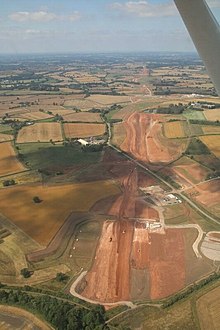Construction industry of the United Kingdom
The construction industry is one of the major industry sectors in the economy of the United Kingdom, contributing about 6% of UK gross value added in 2019.[1] In 2018, it was, by GVA, the sixth biggest construction sector in the world.[2]
Scale and composition
[edit]Before the COVID-19 pandemic, the value of construction new work peaked at £119,087 million in 2019, dropping to £99,651 million in 2020.[3] Of this total, new housing comprised £37,755 million of new work, infrastructure £22,517 million, and private commercial building £24,614 million.[3] Public sector work (housing, infrastructure, other) accounted for 26% by value of new work in 2020.[3]
The construction sector employed around 2.1 million workers (1.4 million employed in just over 342,000 VAT/PAYE-registered businesses, plus 727,000 self-employed) in Great Britain in 2020,[3] with a high proportion of small businesses:[1] just over one million small/medium-sized businesses (SMEs), mainly self-employed individuals, worked in the sector in 2019, comprising about 18% of all UK businesses.[1] Tier 1 suppliers in 2013 estimated that 50% by value of their government construction work and supply was delivered by SME sub-contractors and suppliers.[4] Over a third of construction businesses in 2020 were located in London and south east England.[3] Women comprised 12.5% of the UK construction workforce in 2019.[5]
Industry strategy
[edit]
Productivity in construction remains below the UK average and has changed little in the past 50 years.[6] As a result, the UK government has repeatedly tried to improve the sector's efficiency, publishing (among others) the Latham Report in 1994, the Egan Report in 1998 and the Farmer Review in 2016; in 2013 it launched the Construction 2025 industrial strategy,[7] which has since been updated through the 2018 industrial strategy, the 2019 Construction Sector Deal, the 2020 Construction Playbook, and the 2021 Transforming Infrastructure Performance: Roadmap to 2030.
As of 2022[update], the largest construction project in the UK is construction of the High Speed 2 rail line between London and the West Midlands. Prior to completion of construction, Crossrail was Europe's biggest construction project.[8][9]
The industry was pushed into a period of turmoil following the Brexit vote in June 2016. Fears of post-Brexit EU labour shortages were cited as a key reason for the uncertainty.[10][11][12] Further disruption followed during the COVID-19 pandemic from 2020 onwards, and there were inflationary pressures as a consequence of rising fuel prices following the 2022 Russian invasion of Ukraine.
In 2023, the construction industry accounted for 11% of UK company insolvencies as businesses were affected by rising inflation and interest rates.[13]
Health and safety
[edit]Construction accounted for 39 of the 142 work fatalities reported in 2021-22,[14] with half of deaths over a five-year period attributed to falls from height.[15] Construction's fatal injury rate (1.62 per 100,000 workers) is around four times higher than the all industry rate.[15] Around 1.8% of construction workers reported musculoskeletal disorders - a higher rate than for workers across all industries (1.1%).[15]
See also
[edit]References
[edit]- ^ a b c Rhodes, Chris (16 December 2019). Briefing Paper: Construction industry: statistics and policy. London: House of Commons Library.
- ^ Source: National Accounts Estimates of Main Aggregates | United Nations Statistics Division. Gross Value Added by Kind of Economic Activity at current prices - US dollars. Retrieved 26 June 2020.
- ^ a b c d e "Construction statistics, Great Britain: 2020". Office for National Statistics. Retrieved 19 April 2022.
- ^
 This article incorporates text published under the British Open Government Licence: Cabinet Office, Making Government business more accessible to SMEs: Two Years On, page 6, published on 8 August 2013, accessed on 25 September 2024
This article incorporates text published under the British Open Government Licence: Cabinet Office, Making Government business more accessible to SMEs: Two Years On, page 6, published on 8 August 2013, accessed on 25 September 2024
- ^ "Construction industry just 12.5% women and 5.4% BAME". GMB Union. 24 October 2019. Retrieved 25 September 2024.
- ^ "Productivity in the construction industry, UK: 2021". Office for National Statistics. Retrieved 19 April 2022.
- ^ "Construction 2025" (PDF). HM Government. Retrieved 10 December 2017.
- ^ "Crossrail's giant tunnelling machines unveiled". BBC News. 2 January 2012.
- ^ Leftly, Mark (29 August 2010). "Crossrail delayed to save £1bn". The Independent on Sunday. London.
- ^ Inman, Phillip (4 July 2016). "Construction becomes first casualty of Brexit as housebuilders get jitters". The Guardian. ISSN 0261-3077. Retrieved 11 July 2017.
- ^ "Brexit vote sparks biggest plunge in construction since the financial crisis". The Independent. 2 August 2016. Retrieved 11 July 2017.
- ^ ""Brexit could worsen construction skills crisis"". ITV News. Retrieved 11 July 2017.
- ^ "Construction industry accounted for 11% of UK administrations in 2023, analysis reveals". Building, Design & Construction. 4 August 2023. Retrieved 4 August 2023.
- ^ "Work-related fatal injuries in Great Britain". HSE. Health & Safety Executive. Retrieved 19 April 2022.
- ^ a b c "Construction statistics in Great Britain, 2021" (PDF). HSE. Health & Safety Executive. Archived from the original (PDF) on 26 January 2022. Retrieved 19 April 2022.
